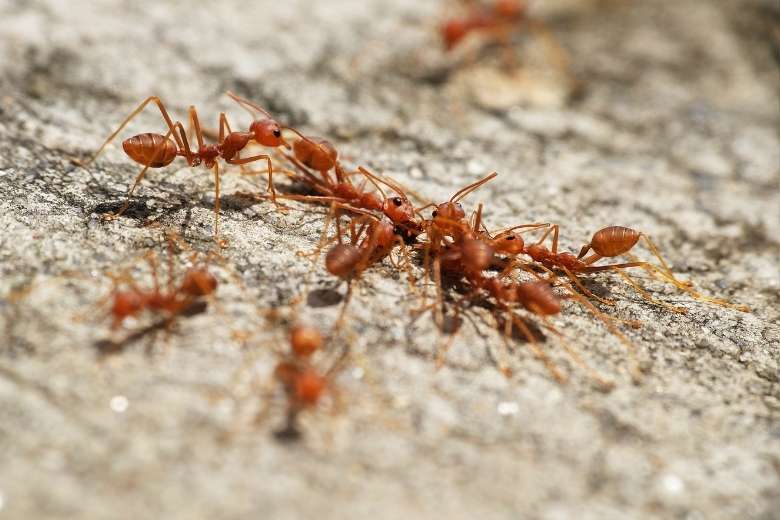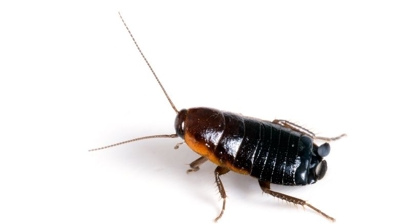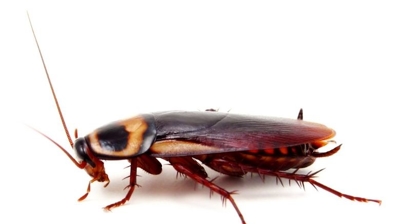
Fire Ant Control Services

Fire Ants
Fire ants are considered harmful in several ways, affecting both human health and the environment. Here are some of their potential dangers:
- Human Health Risks: Fire ants are infamous for their painful stings. When a fire ant stings, it injects venom that causes an intense burning sensation, which can result in redness, swelling, and itching. Some individuals may experience more severe reactions, including anaphylaxis, which can be life-threatening. Multiple stings, especially in clusters, can lead to more serious reactions, including systemic issues like dizziness, nausea, and even cardiac arrest in rare cases.
- Increased Risk in Public Spaces: Fire ants can create dangerous situations in public spaces such as parks, playgrounds, and lawns. Their nests are often hidden, and people may inadvertently disturb them, leading to swarms of aggressive ants. This is particularly dangerous for young children or individuals with allergies to ant venom.
- Damage to Infrastructure: Fire ants are known to nest in and around man-made structures. Their nests can damage electrical equipment, as fire ants are attracted to electricity and have been known to cause short circuits and malfunctions in machinery, transformers, and air conditioners. This behavior leads to costly repairs and downtime for businesses and infrastructure.
- Livestock Threat: Fire ants also pose a risk to livestock, particularly young animals like calves or lambs. Livestock can suffer from multiple stings, which may result in pain, infection, or even death in extreme cases, especially when these ants swarm vulnerable areas, such as the eyes, nose, or genitals.
Fire ants present a multifaceted challenge due to their aggressive nature, ability to disrupt ecosystems, and potential to harm both human health and agriculture.
Learn more: Do Fire Ants Bite? || Fire Ants Sting || What Do Fire Ants Eat?
Fire Ant Removal
Getting rid of fire ants is crucial for several reasons:
Health Risks
- Painful stings: Fire ants deliver a venomous sting that causes intense pain, itching, and a burning sensation. The name “fire ant” reflects this sensation.
- Allergic reactions: Some people can develop severe allergic reactions, including anaphylaxis, which can be life-threatening without prompt treatment.
- Secondary infections: Scratching stings can lead to open wounds, increasing the risk of bacterial infections.
Environmental Impact
- Disruption of ecosystems: Fire ants are aggressive predators that displace native ant species and other insects, disrupting local biodiversity.
- Threat to wildlife: They attack ground-nesting birds, small mammals, reptiles, and even hatchlings, reducing survival rates for native species.
- Damage to vegetation: Fire ants feed on seeds and young plants, potentially affecting natural plant regeneration.
Agricultural and Property Damage
- Crops and livestock: Fire ants damage crops by feeding on seeds, seedlings, and fruit. They can also attack livestock, causing stress, injuries, or even fatalities in extreme cases.
- Electrical systems: Fire ants are known to invade electrical equipment, including air conditioning units and transformers, leading to short circuits and costly repairs.
- Property damage: Their mounds can damage lawns, golf courses, and recreational areas, making them hazardous and unsightly.
Economic Consequences
- Healthcare costs: Treating stings, infections, and allergic reactions adds financial burden.
- Agricultural losses: Damage to crops and livestock translates to significant financial impact for farmers and communities.
Rapid Spread and Colonization
Fire ants establish large, interconnected colonies with multiple queens, making infestations difficult to eradicate once established. They spread quickly, colonizing new areas and increasing the severity of problems over time.
Fire ants are not just a nuisance—they are a serious threat to health, the environment, agriculture, and property. Controlling and eliminating them promptly helps prevent escalating damage and protects both human and ecological well-being.
Learn more: How To Get Rid Of Fire Ants
Fire Ant Control
Our professional fire ant control services are highly recommended because these pests are aggressive, resilient, and notoriously difficult to eliminate with DIY methods alone. Here are some of the reasons why bringing in our professionals is the best choice:
- Effective, Long-Term Results: Fire ants build large underground colonies with multiple queens, which makes them very difficult to wipe out completely. Over-the-counter products often only kill surface workers or a portion of the colony, leading to quick reinfestations. Our professionals use advanced baits and treatment techniques designed to eliminate entire colonies, including queens, for lasting relief.
- Safety and Protection: Fire ants deliver painful stings that can cause welts, allergic reactions, and in some cases, serious medical emergencies. Our professionals ensure that infestations are removed quickly and thoroughly, reducing the risk of stings to you, your family, pets, or employees.
- Customized Treatment Plans: Every property is different. Our professionals will inspect your yard, identify mound locations, determine colony size, and select the most effective treatment strategy for your specific situation. This customized approach prevents wasted time and money on ineffective DIY methods.
- Preventive Maintenance: After eliminating existing colonies, our professionals set up scheduled treatments to keep fire ants from returning. This preventive approach protects your lawn, landscaping, and peace of mind year-round.
- Protection for Property Value and Outdoor Living: Fire ants can damage turf, plants, and landscaping features. For homes, businesses, schools, and parks, professional fire ant control protects the value of the property and ensures outdoor spaces remain safe and usable.
While DIY treatments may seem cheaper up front, repeated infestations and wasted products often cost more over time. Our professional fire ant control provides a reliable, long-term solution, saving money and hassle in the end.
Fire Ant Exterminators
Hiring our local exterminators for fire ant control often provides significant advantages over national brands because our local specialists bring knowledge, responsiveness, and customized solutions that large companies often do not:
Expertise in Local Conditions
- Understanding local species: Fire ant species can vary regionally, and our local exterminators know the specific species in the area, their nesting habits, and seasonal behavior.
- Tailored treatment plans: Our local experts select the most effective control methods for your property’s soil type, vegetation, and microclimate, increasing success rates.
- Awareness of local regulations: We understand state or county pesticide rules, ensuring treatments are both legal and safe.
Rapid Response and Accessibility
- Faster service: Our local team can respond quickly to infestations, which is critical since fire ants spread rapidly.
- Ongoing support: Our local exterminators provide follow-up visits and monitoring, ensuring colonies are fully eradicated.
- Personalized communication: You deal directly with people familiar with your property rather than call centers or remote customer service teams.
Customized and Integrated Solutions
- Integrated pest management (IPM): Our local exterminators often combine baiting, mound treatment, and habitat modification strategies tailored to your property, rather than a one-size-fits-all approach.
- Long-term prevention: We can advise on landscaping adjustments, soil treatments, and moisture management to reduce re-infestation risk.
Cost-Effectiveness
- Targeted treatments: Our local specialists focus on effective, targeted methods, often reducing the number of unnecessary applications compared to standardized national programs.
- Flexible scheduling: We can coordinate treatments to match peak activity periods for fire ants, improving efficiency and outcomes.
Knowledge of Local Risks
Local exterminators understand neighborhood-specific fire ant pressures, such as nearby construction, water sources, or neighboring properties with infestations, which can affect treatment success.
Our local exterminators combine deep regional expertise with responsive, personalized service, making us more effective for persistent fire ant problems than a national brand that applies generalized methods.
What Do Fire Ants Look Like?
Fire ants are distinctive in appearance, and their physical characteristics make them easily recognizable. These ants are generally small in size, measuring between 1/16 to 1/4 inch (1.6 to 6.4 millimeters) in length. Here is a description of what fire ants look like:
- Color: Fire ants are typically reddish-brown to reddish-black in color. They have a reddish head and thorax (the middle segment of their body) with a slightly darker abdomen. This reddish coloration is one of their key identifying features.
- Body Structure: Fire ants have a two-segmented waist (petiole and postpetiole), which gives their abdomen a distinct attachment to the rest of their body. This feature sets them apart from many other ant species.
- Mandibles: Their mandibles (jaws) are strong and equipped with sharp teeth, which they use for grasping, biting, and cutting food.
- Antennae: Fire ants have two antennae on their head, which are segmented and typically bent at a 90-degree angle.
- Eyes: They possess compound eyes, but their vision is generally poor, and they rely more on their sense of touch and chemical cues for navigation.
- Stinger: On the rear end of their abdomen, fire ants have a sharp, retractable stinger. They use this stinger to deliver painful stings when they perceive a threat or are provoked.
- Size Variation: Fire ant colonies consist of different castes, including workers, queens, and males. Worker ants are typically the ones encountered and vary in size within the colony. The size of worker ants can range from small to large, with the smaller ones usually performing tasks like foraging and tending to the brood, while the larger ones are responsible for defense.
Fire ants are small ants with a reddish-brown to reddish-black coloration, a two-segmented waist, sharp mandibles, segmented antennae, compound eyes, and a stinger. These characteristics, along with their aggressive behavior and painful stings, make them easily distinguishable from other ant species.
Where Are Fire Ants Found?
Fire ants are primarily found in regions with warm, temperate climates. They are most prevalent in the southern United States and South America, where the climate is suitable for their survival and reproduction. Here are some specific areas and habitats where you might encounter fire ants:
- Southern United States: Fire ants are particularly common in the southern states of the United States, including Texas, Florida, Louisiana, Mississippi, Alabama, and Georgia. They have also spread to parts of North Carolina, South Carolina, and Oklahoma.
- South America: Fire ants are native to South America and are found in countries such as Brazil, Argentina, and Paraguay.
- Australia: Fire ants have become invasive in some parts of Australia, particularly in Queensland. Efforts are being made to control and eradicate their populations in these regions.
- Southeast Asia: Some species of fire ants have also been reported in parts of Southeast Asia, such as the red imported fire ant (Solenopsis invicta), which has established colonies in Taiwan and the Philippines.
- Urban and suburban areas: Fire ants are often found in residential neighborhoods, parks, golf courses, and other urban or suburban environments. They build their nests in lawns, gardens, and open areas, making them more likely to come into contact with humans.
- Agricultural areas: Fire ants can be a significant problem in agricultural regions, as they can damage crops and harm livestock. They are often found in fields and pastures.
- Natural habitats: Fire ants can also be found in natural habitats like grasslands, forests, and along riverbanks.
The distribution of fire ants may change over time due to both natural factors and human activities. In regions where fire ants are prevalent, it's essential to take precautions to avoid their stings, as they can be painful and, in some cases, dangerous, especially for individuals who are allergic to their venom.
Fire Ant Life Cycle
The life cycle of fire ants follows a typical pattern for ants, characterized by distinct stages, including the egg, larva, pupa, and adult. Here is an overview of the life cycle of fire ants:
- Egg Stage: The life cycle begins when the queen ant lays eggs. The eggs are typically small, oval, and white. The queen usually deposits the eggs deep within the ant nest, where they are protected and can maintain a stable temperature and humidity. The time it takes for eggs to hatch depends on factors like temperature and ant species.
- Larva Stage: Once the eggs hatch, they give rise to larvae. Ant larvae are legless and grub-like, and they are entirely dependent on the worker ants for food. Worker ants feed the larvae a diet of regurgitated liquids and solid foods. The larvae grow rapidly during this stage, and they molt several times as they increase in size.
- Pupa Stage: After the larval stage, the ants enter the pupal stage. In this stage, they undergo metamorphosis, transitioning into adult ants. The pupae are usually enclosed in silk cocoons spun by the larvae. They are immobile and do not eat during this phase. The pupal stage is a critical period for the development and differentiation of ant body structures.
- Adult Stage: Once the development in the pupal stage is complete, the mature ants emerge as adults. They are fully developed and capable of performing their roles within the ant colony. Adult fire ants are divided into different castes, including queens, males (drones), and workers. Worker ants are responsible for foraging, nest maintenance, and defending the colony, while the queen's primary function is to lay eggs to maintain the colony. Male ants' main role is to mate with the queen.
The life cycle of fire ants can vary in duration depending on factors such as ant species, temperature, and environmental conditions. Generally, the entire cycle from egg to adult can take several weeks to a few months. Fire ant colonies are highly organized and efficient in managing their life cycle, which contributes to their success as invasive and aggressive ants.

Hear From Our Happy Customers
-
"Great Communication"
Tech was on time, communication was great, and he accommodated my needs.
- Alonzo W. -
"Professional & Considerate"
I’m pleased with Miche services. Jarvis came today. Professional and considerate. Thank you!
- Judy B. -
"Fantastic & Patient"
Jarvis was fantastic and patient. He answered my questions with an in-depth explanation and addressed all of my areas of concern. Would love for him to be my assigned tech going forward. Well done!
- Yonnette M. -
"Very Knowledgeable"
The tech that arrived was courteous, professional, and very knowledgeable. He was Great.
- Uerial I. -
"Exceeds Expectations"
I can’t say enough positive things about this company... The tech that came out, Jarvis went above and beyond my expectations. Thank you guys, I will continue using your services.
- Jake M. -
"Wonderful Service"
Wonderful service. Jarvis is great. Took care of everything I needed. Thank you!
- Henry P.



